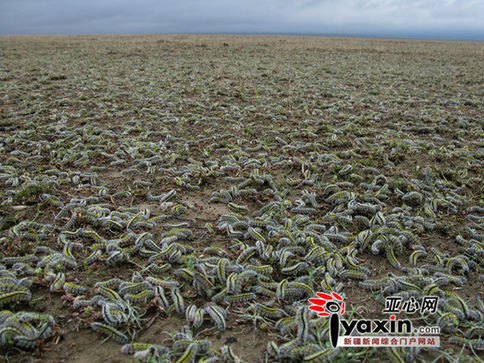Experts from Beijing have joined other Chinese scientists in trying to identify the mystery caterpillars that are destroying pastures in the northwestern Xinjiang Uygur Autonomous Region.
|

|
|
Photo taken shows an invasion of mystery caterpillars in Usu, Xinjiang Uygur Autonomous Region.
|
"We are waiting for the caterpillars to change into chrysalides, and will be able to identify them only after moths are produced," said Gao Song, a researcher with the Beijing-based Chinese Academy of Agricultural Sciences.
Gao arrived in Xinjiang on Monday to observe samples of the 2-cm thorny green caterpillar with black stripes at a laboratory of Xinjiang Agricultural University. He and his colleagues were expecting to identify them from the size, color, wings and genitalia of the moths.
"The mystery may remain unsolved for months if the caterpillars choose to estivate in the hot, arid summer and postpone their metamorphosis until the fall," he said Thursday.
Su Hongtian, an expert with Ministry of Agriculture, has taken samples of the caterpillars to Beijing, where he hopes to use DNA technologies to identify their species.
"If their DNA data is not in the existing databank, we, too, need to wait until moths are produced," said Su.
The caterpillars have damaged 8,000 hectares of grassland in Usu and forced nearly 20,000 head of livestock and 50 herding families to leave.
It was the worst plague of caterpillars in three decades in the city about 280 km west of the regional capital of Urumqi.
Local herders and entomologists claimed they had never seen the caterpillars before.
Xinjiang has a history of using chickens, ducks and other birds to fight locusts, which are also a menace to grassland. However, the birds showed no interest in the thorny caterpillars in Usu.
The Usu municipal government announced a grazing ban on affected grassland on Saturday and has used spray vehicles to fight the plague with pesticide.
"We expect all the caterpillars to be killed by this weekend," said Mu Chen, an official with the Xinjiang regional headquarters of locust and rodent control.